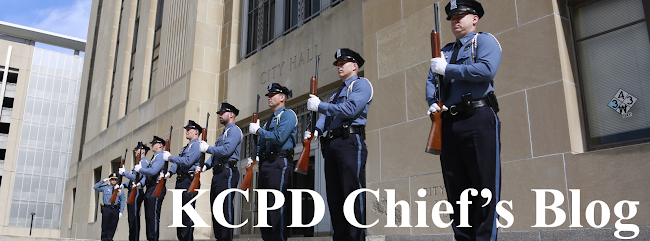Officer Adam Baker was unprepared for what would happen after he was in a fatal officer-involved shooting.
With all his Marine and KCPD training, he thought everything would be fine. But then came the night terrors. Then no sleep for four days at a time, and anxiety that rendered him unable to leave his house except for appointments with the Department psychologist. One medication after another. A wife who was terrified and didn’t know what to do to help him.
“It made me really feel like I’m broken, and I can’t get fixed,” Officer Baker said.
Then one of the Department’s psychologists, Kay White, suggested Baker try the Save a Warrior program. After launching in Malibu, Calif., it came to Kansas City last fall. It is “an innovative, evidence-based program that provides a powerful healing experience for active-duty military, veterans and first responders who are suffering from post-traumatic stress,” according to the organization’s web site. The site states 22 “warriors” commit suicide every day in the United States.
Adam Magers, the project director of Kansas City’s Save a Warrior program, attended the one in Malibu and thought it was so powerful and life-changing that he wanted to make Kansas City the organization’s second location. The first K.C. cohort, or 5-day course, took place in fall 2014.
Magers said Save a Warrior’s founder, Jake Clark, was a military veteran but also had served in the FBI, U.S. Secret Service and at the L.A. Police Department.
“He had just as much drama from law enforcement as he did from his time in the military, and it took him 13 years to overcome it,” Magers said. “… If there’s anyone who needs this program, it’s police officers.”
Los Angeles Police officers have found great success in the program, so when it started here, Magers wanted to see if Kansas City Police would be interested. An architect working on the Headquarters renovation project, Dale Duncan, runs the Spencer Duncan Make it Count Foundation in honor of his son, who died when his helicopter was shot down in Afghanistan. The Foundation supports organizations that help veterans, including Save a Warrior. He introduced Crisis Intervention Team (CIT) Commander Captain Darren Ivey to the program. Then he, Ivey and Magers sat down with Chief Darryl Forté, who agreed it would be an excellent opportunity for officers experiencing post-traumatic stress. The Spencer Duncan Foundation and Kansas City Royals Charities have so far paid for KCPD members to attend. It costs about $2,500 per participant for the cohort.
Officer Baker said it’s not just for people like him who are involved in critical incidents. It’s also for officers who experience hardship day after day and never get to decompress.
“After you have to see an abused or dead baby during the day, how are you supposed to act when you go home to your own kids at night?” he asked. “You have to push that stuff down. It builds up.”
Captain Ivey presented about Save a Warrior at a commanders’ meeting in April. He told the commanders to let him know if they knew of anyone who could benefit from the program.
“I was still presenting, and my phone started blowing up with e-mails,” Captain Ivey said. “They said stuff like, ‘This person would be perfect,’ and ‘I’d like to volunteer.’”
He said he was surprised by the outpouring from his fellow officers because many view police as macho, stodgy and unconcerned about emotional well-being.
“It seems we’ve evolved,” he said. “Overall wellness is really becoming part of our culture now.”
Officer Baker was part of the first group of three KCPD officers to go through Save a Warrior. Another three graduated as part of the 13-person cohort on May 8. Baker said the program focuses on how warriors throughout history have been able to overcome trauma, and it offers things like meditation and peer support as tools to do so. The majority of people who come to Save a Warrior are suicidal, according to the organization’s web site. Baker said he hadn’t reached that point yet, but he was in enough pain to know he needed something quickly.
“It literally is like looking in a mirror when you go there,” he said. “You really understand that all of us are going through the exact same problems.”
Officer Baker said that thanks to the program, he is healing and has regained his sense of self-worth. He went back as a “shepherd” with the May cohort, to serve as support and share his experiences.
